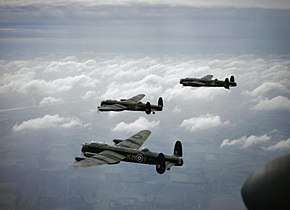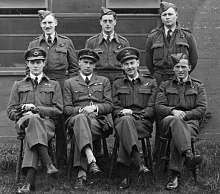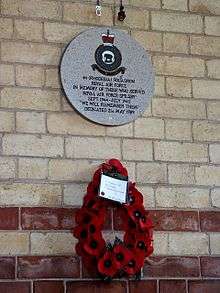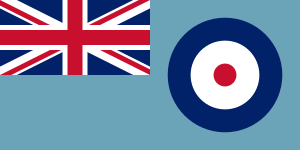No. 44 Squadron RAF
No. 44 (Rhodesia) Squadron was an aviation unit of the Royal Air Force. It was active between 1917 and 1982. For most of its history it served as a heavy bomber squadron.
| No. 44 (Rhodesia) Squadron RAF | |
|---|---|
 No. 44 Sqn Avro Lancaster B.I in flight, 29 September 1942 | |
| Active | 24 July 1917 – 1919 March 1937 - 21 December 1982 |
| Country | |
| Branch | |
| Motto(s) | Latin: Fulmina regis iusta ("The King's thunderbolts are righteous")[1] |
| Battle honours | Home Defence, 1917–18*; Channel & North Sea, 1939–45*; Invasion Ports, 1940*; German Ports, Baltic, 1940–45; France & Low Countries, 1940; Biscay Ports, 1940–44; Ruhr, 1940–43 & 1945*; Berlin 1940–44*; Atlantic, 1942; Normandy, 1944*; Rhine, 1940–44*; Fortress Europe, 1940–44*; France & Germany, 1944–45; Walcheren. Honours marked with an asterisk* are those emblazoned on the Squadron Standard |
| Commanders | |
| Notable commanders | Arthur "Bomber" Harris |
| Insignia | |
| Squadron Badge | On a mount, an Elephant |
| Squadron Codes | JW (Oct 1938 – Sep 1939) KM (Sep 1939 – Jan 1951) |
History
44 Squadron was formed on 24 July 1917 as a Home Defence unit forming part of the London Air Defence Area. The squadron, based at Hainault Farm, Essex, pioneered the use of the Sopwith Camel in night fighter operations. By the end of the First World War it was commanded by Arthur Harris, later known as Bomber Harris.
Disbanded in 1919, the squadron was reformed as a bomber squadron in March 1937 and equipped with Hawker Hinds. Moving to RAF Waddington later that year, it was equipped with Bristol Blenheims before changing to Handley Page Hampdens. During the war the squadron was subsequently based at RAF Dunholme Lodge,[2][3] near Dunholme, then RAF Spilsby at Great Steeping in Lincolnshire.[4][5]

At the outbreak of the Second World War, as part of Bomber Harris' No. 5 Group, the squadron was commanded by John Boothman, winner of the Schneider Trophy in September 1931. It was one of only two squadrons to operate continuously throughout the war. There were two squadron commanders who held the Victoria Cross – Wing Commanders Roderick Learoyd and John Nettleton.
In 1941 the squadron was renamed No. 44 (Rhodesia) Squadron in honour of that colony's contribution to Britain's war effort, and also to recognise that up to 25% of the ground and air crew were from Southern Rhodesia. The badge is based upon the seal of Lo Bengula ,the chief of the Matabele on conquest. The seal shows an elephant which, in the case of this unit, is intended to indicate heavy attacks.
No. 44 received its first Avro Lancaster, in late 1941 and became the first squadron to convert completely to Lancasters, flying their first operational missions in the aircraft on 3 March 1942.[6] Total sorties and losses for the war were:
- Handley Page Hampden – 2,043 sorties (43 lost)
- Avro Lancaster – 4,362 sorties (149 lost, plus 22 destroyed in crashes)
The squadron suffered the third highest overall casualties of RAF Bomber Command. In July 1945 the squadron exchanged places with No. 75 Squadron in RAF Mepal in Cambridgeshire to prepare for transfer to Tiger Force in the Far East for the war on Japan.
After the war (from 1946–1947) the squadron was re-equipped with Avro Lincolns, converting to the Boeing Washington (the RAF name for the B-29 Superfortress in British service, 1951) and then the English Electric Canberra during the Suez Crisis before disbanding on 16 July 1957.
Reformed yet again at RAF Waddington during 1960 as part of RAF Bomber Command's V bomber force maintaining the UK's strategic nuclear deterrent, the squadron was equipped with the Avro Vulcan B1 from Aug 1960, upgraded to the Vulcan B1A in January 1961. Both types were equipped with various free-fall nuclear weapons.[7] These may have included Blue Danube, US Mk 5 supplied under Project E, Red Beard, Yellow Sun Mk.1, and certainly Yellow Sun Mk2.
After the advent of effective Soviet SAMs forced Bomber Command to reassign V bombers from high-altitude operations to low-level penetration operations, the squadron's Vulcans adopted a mission profile that included a 'pop-up' manoeuvre to 11,000 ft for safe release of Yellow Sun Mk2. The aircraft was then leveled off at about 10 miles or less from the target. In training this distance tended to creep until the aircraft would have been vulnerable to SAM. A new manoeuvre was developed by the research branch and the Bomber Command Development Unit. This required aircraft to home to a specific point at a distance from the target based on the mark of aircraft and its engines. In the case of 44 Sqn with the Mk 1a Vulcan, this point was some 21,000 yards from the target. The aircraft would then be set in a climb at a specified angle of about 12 degrees for the Mk1a. As the aircraft passed 10,500 feet the bomb would be released. This was crude dead reckoning, and the Mk 1 crews realized that the ballistic computer in the NBC could calculate a much more accurate release point. The crews determined to use the automatic computing. Occasionally in training the pull up was late and the release would occur at a much lower altitude. This risked either a weapon failure or suicide from an early burst. In January 1968 the squadron was re-equipped with eight Vulcan B2 aircraft[7] and eight WE.177B laydown bombs[8] which improved aircraft survivability by enabling aircraft to remain at low-level during weapon release.[9]
Following the transfer of responsibility for the nuclear deterrent to the Royal Navy the squadron was reassigned to SACEUR[8] for tactical strike missions. In a high-intensity European war the squadron's role was to support land forces resisting a Soviet attack into Western Europe by striking deep into enemy-held areas beyond the forward edge of the battlefield, striking at enemy concentrations and infrastructure, first with conventional weapons and secondly with tactical nuclear weapons as required, should a conflict escalate to that stage.
The squadron's Vulcan B2s served mainly in that low-level penetration role until 1982[10] when they saw action during the Falklands War. No. 44 Squadron was then disbanded on 21 December 1982.[11]
Honours

During World War II, a number of decorations were awarded to members of 44 Squadron.[12] These included one Victoria Cross awarded to Wing Commander J.D. Nettleton, six Distinguished Service Orders, one Conspicuous Gallantry Medal, one Air Force Medal, one British Empire Medal, 151 Distinguished Flying Crosses, one bar to a DFC and 97 Distinguished Flying Medals.
See also
- List of Royal Air Force aircraft squadrons
- Royal Rhodesian Air Force
References
Notes
- Pine, L.G. (1983). A dictionary of mottoes (1 ed.). London: Routledge & Kegan Paul. p. 88. ISBN 0-7100-9339-X.
- Unofficial history of RAF Dunholme Lodge
- Official history RAF Dunholme Lodge Archived 9 January 2007 at the Wayback Machine
- Unofficial history of RAF Spilsby
- Official history of RAF Spilsby Archived 9 January 2007 at the Wayback Machine
- White 2007, p. 58
- Global Security.org/wmd/world/uk/44sqn.htm
- RAF nuclear front line Order-of-Battle 1968
- Weapon overview @ www.nuclear-weapons.info/vw.htm#WE.177 Carriage
- RAF nuclear front line Order-of-Battle 1982
- Global Security.org/wmd/world/uk/44sqn.htm
- White 2007, p. 209.
Bibliography
- Dives, William K. DFC. A Bundu Boy In Bomber Command. Trafford Publishing, 28 July 2003. ISBN 1-55395-879-9. The memoirs of a Rhodesian pilot, Flying Officer William Dives DFC from No. 44 (Rhodesia) Squadron.
- White, MINucE Alan N, Bsc. and Air Commodore Simon Baldwin. The King's Thunderbolts – No. 44 (Rhodesia) Squadron Royal Air Force: An Operational Record and Roll of Honour 1917–1982. Tucann Design & Print, 2007. ISBN 978-1-873257-85-2.
- White, Flt.Lt. Alan N. 44 (Rhodesia) Squadron RAF on Operations: An Operations Record and Roll of Honour. Self-Published by A.N. White to commemorate the Diamond Jubilee of No 44 Squadron RAF, 1977.
External links
| Wikimedia Commons has media related to No. 44 Squadron RAF. |
- Royal Air Force History No. 44 (Rhodesia) Squadron
- Sopwith Camel pilot of No. 44 Squadron, Lieutenant George Robert Craig M.C. Family website.
- John Coutts – Thirty Missions Family website
- F.Sgt J.E. Wainwright Family website, includes a brief Squadron history
- RAF Spilsby and its Squadrons Includes brief history, and comprehensive list of No. 44 Squadron casualties.
- Air of Authority No. 44 Squadron history
- No. 44 Squadron Aircraft & Markings
- 44 Squadron Bomber Command
- 44 Squadron at the International Bomber Command Centre Digital Archive.
